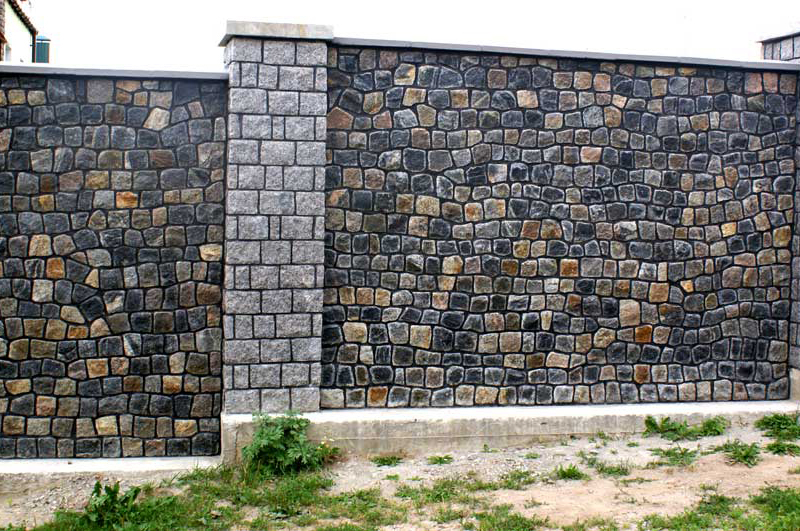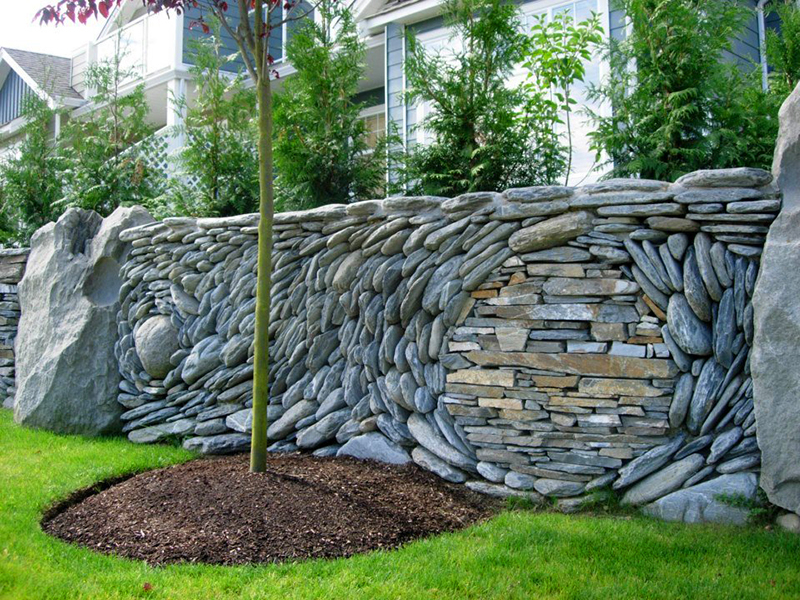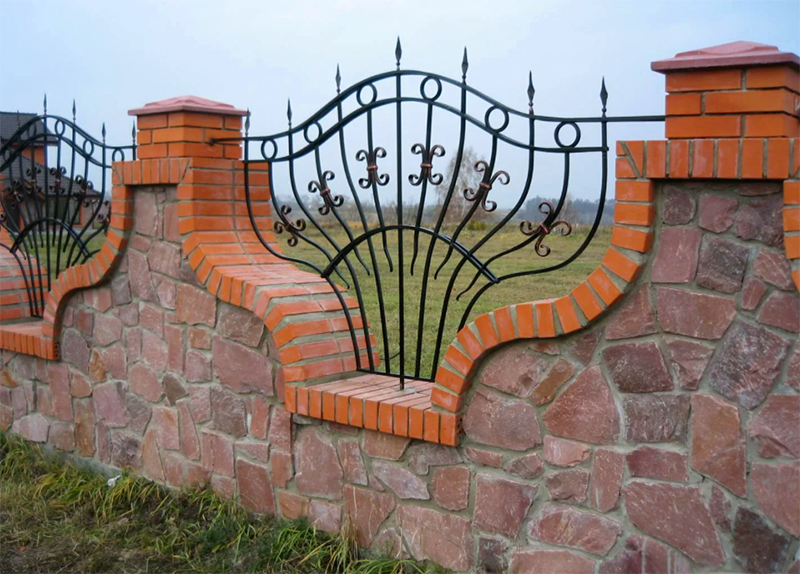Profiled sheet fences have captured the territories of dacha associations, and the plots have become so similar to each other that you can get lost. Another thing is if the fence is different from the others, it looks stylish and expensive. This can be easily achieved by building a stone fence. And if we talk about a prestigious form, then it’s better not to come up with. Do you think it's too expensive? In vain. In fact, it is quite possible to build such a fence on your own and literally from what is under your feet. How to cope with such a task - we will discuss in this material.
Read in the article
- 1 The nuances of the construction of stone fences
- 2 How to choose stones for the fence
- 3 Masonry for a stone fence: we select the appropriate type
- 4 Is it worth building a stone fence: the pros and cons of such a decision
- 5 Possibilities of combining stone with other materials in the fence
- 6 How to build a stone fence: a step by step algorithm
- 6.1 What is required for a stone fence
- 6.2 Don't Forget About Calculations
- 6.3 Preparatory work
- 6.4 Foundation stone fence
- 6.5 Stone fence posts
- 6.6 How to lay out spans in a stone fence
- 6.7 How to finish stone fences
- 7 The most budget option for a stone fence - gabions
The nuances of the construction of stone fences
So you want to make a stone fence but don't know where to start? A fence of this type is a capital and solid construction, which requires the preparation, if not of a project, then at least of a preliminary plan. A little time to think through the details - and you will protect yourself from possible alterations, which, as you know, are not cheap.

If you want to limit the use of stone to pillars, then you still need both a foundation and a rigid bundle of spans. Unreasonable savings on the organization of the foundation always turns into a complete collapse, up to the impossibility of repair.
In order to correctly calculate the foundation, it is imperative to first study the soil on the site. Both the project and the costs depend on its bearing capacity and the level of groundwater. Remember that the foundations are also different, and in each case, you can choose the appropriate type.
How to choose stones for the fence
Stones are a material that is not necessary to purchase, because you can get them yourself. Although, if you do not have time for this, you can buy a stone suitable for such a structure in any construction market.
What stones are suitable for building fences:
- cobblestones. You will find these stones literally under your feet. Large boulders might work too. Cobblestones are durable and workable. If you need to adjust the stone to size, it can be split with a hand tool. In the construction markets, such stones can also be found and, in comparison with other rocks, they are inexpensive.

- Granite. A very durable and reliable material, which is not easy to process without a special tool.

- Dolomite. Such fences are easy to identify by color: they are either gray or white. The texture of this material is rich, it can be easily processed by hand and has exceptional durability.

- Shell rock or limestone. In the places of its extraction, one cannot come up with a better material for the fence. The weight of such stones is relatively small, which reduces the cost of the foundation.

- Sandstones. They have different colors and look very presentable both in fences and in facade decoration.

- Pebble. Another natural material that you can prepare with your own hands. Colored smooth pebbles can become a kind of mosaic to create real masterpieces.

- Butovy stone. This is a multi-colored material that also fits perfectly into the concept of a stone fence.

- Fake diamond use if buying natural is too expensive. This type of finishing material is made from concrete using dyes.

Masonry for a stone fence: we select the appropriate type
Stone masonry has several varieties. Before you get started, take a look at the examples in this photo gallery and choose the option that suits you best.

The binder solution in this case is the usual one, as for brickwork. With wild masonry, do not rush. The weight of the stones is quite large, so each row must be given time for the mortar to harden and the stones to be firmly fixed in their places.
After that, the remaining empty gaps in the masonry are filled with a cement-sand mixture through a bag with a cut off corner (it turns out something like a confectionery syringe). When all the voids are filled, you can embroider the seams. In wild masonry, large stones are placed in the outer planes, and the gaps between them are clogged with debris and small stones. Sandstone, rubble, dolomite, various slates are most suitable for it.

Plank masonry looks more ordered than wild masonry, is more stable and requires much less mortar. For this type of fence, stones are selected that are easy to process: limestone, sandstone.

The laying principle is the simplest, layered, fastening is carried out with the same binder solution. The best material for such fences is layered slate.

To form the wall of the fence, formwork is first made. Then it is filled in layers with stones, interspersed with mortar. After solidification of the total mass, the formwork is removed.
In principle, it is not difficult to work with natural material. Even with a complete lack of skills, you will quickly master the algorithm.
Is it worth building a stone fence: the pros and cons of such a decision
A stone fence is a more permanent structure, so keep in mind that what you build will "an eyesore" on your eyes for the rest of your life. The minimum service life of such a fence is half a century, and if you approach the construction with due diligence, then more than one hundred years.

If you have the opportunity to get a stone for free, this construction site can be safely called a budget one. And since the material is natural, there are no questions from an environmental point of view.
And finally, natural stone always looks expensive and prestigious. If you think over the architectural style of your site so that the stone compositions echo in the buildings, you will get a chic ensemble.
Among the shortcomings, it must be recognized that the arrangement of the foundation is troublesome and costly. Even the savings on independently mined stone pales in comparison with what has to be poured into the foundation.
Possibilities of combining stone with other materials in the fence
They are literally limitless. Stone is a versatile material that can be safely combined with literally anything: wood, brick, and corrugated board.
The most popular combination method is the use of stone pillars: the base of the fence and the pillars are made of masonry, and the spans are filled with other material.
The combination of wood and stone looks very organic. You can "play" with the location of the boards, curly cutouts, woodworking.

The combination of stone and brick looks quite worthy, especially if the same motif is repeated, for example, in the design of the facade of the house.

Decking? Why not. A metal profile is embedded in stone pillars for fastening steel sheets.


How to build a stone fence: a step by step algorithm
It is not difficult to build a stone fence, the main thing in this matter is to find the right material, preferably free. If found, then you can get down to business.
What is required for a stone fence
You will need a concrete mixer to mix the masonry mortar and pour the foundation. Without it, manually, it is also possible, but long and labor-intensive.
In addition, you will need tools that masons usually use: a trowel, a shovel, a tape measure, a building level. And for marking the fence and even masonry, you need a cord.
Don't Forget About Calculations
As already mentioned, it is necessary to study the features of the soil on the site, because the depth of the foundation depends on its properties. Be sure to lay the foundation below the freezing level, otherwise frost heaving will nullify all your efforts, despite the impressive weight of the structure.
The height of the stone fences is up to you. Usually fences are built at least two meters high to hide the site from prying eyes from the street.
Preparatory work
The territory on which construction is planned must be cleared of debris and vegetation, mounds, if any, should be leveled, potholes should be filled up.

Foundation stone fence
It has already been said about the depth of the foundation, but its width should be about 15–20 cm wider than the future masonry.
The best choice for a stone fence is a reinforced foundation - tape. At least a small plinth of about 15 cm should rise on the ground.

On average, the depth of the foundation is 70 cm. It can be deeper, depending on the characteristics of the soil, but no less. A sand and gravel cushion is laid at the bottom of the trench, a reinforcing frame is placed inside the formwork and everything is poured with concrete.
Stone fence posts
It is most convenient to place stone pillars using formwork. That is, a frame is made of boards, and it is already filled with stones along with the mortar. You can lay out the pillar without formwork, but this is more likely to make mistakes. Fill up the pillar - and there will already be problems with spans.

We made the first layer of stones - left until the mortar sets. The next day, the formwork was moved higher and work continued. For flat slate, you can use ordinary masonry, as with brick.
How to lay out spans in a stone fence
After the foundation and pillars are ready, you can start laying out the spans. For masonry, the usual ratio of cement and sand in the solution is required - 1: 3.
The most convenient and running size of stones for masonry is up to 25 cm. You can add a dye to the solution - so the masonry will turn out more spectacular.
First, a masonry mixture is applied to the foundation, then boulders are laid out from different sides of the pillars towards each other. To make the masonry even, a cord is pulled between the posts.


Each row must stand for a day for the solution to solidify. After laying the row, make sure that the mortar does not end up on the front side of the masonry.
How to finish stone fences
Natural stone itself looks very decorative, so finishing comes down to removing excess mortar and grouting.

The tops of the pillars of stone fences can be decorated with ceramic or metal caps. The deep color of natural stone will emphasize the lacquer coating.
The most budget option for a stone fence - gabions
If the arrangement of the foundation and masonry is too complicated and costly for you, then the best choice would be a gabion fence.
The principle of its arrangement is as follows: a frame is made of a steel welded mesh and filled with a small stone that does not slip through the cells. If the fence is low (up to a meter), you can, in principle, do without a capital foundation. But for a full-fledged fence, a reinforced tape is still required.
Learn more about the construction of such a fence - in this video:
Would you like a fence like this on your property? If you already have a stone fence, share information about it in the comments!
Hello, my name is Andrey. I am buying information sites. There is…
and if the top layer of foam is not broken, then the lacquer surface greatly reduces the hygroscopic ...
strange reasoning regarding sealing. If the log is doused with sealant, foam ...
In the 80s he worked in one NPO, then hammer enamel was sintered. It turned out great,...
While in the summer I lived in the country a lot of different situations I saw and no one fines anyone. Uch…
You won't find a normal apartment for such a sum in Moscow. Even for a country house that …
Thank you. Briefly and clearly...
Karting. I want to help children! &nbs …
Now there is a very interesting and effective option for heating - plasterboard pas …
Everything is chic, but the emphasis is always on the ratchet. And for me, for example, it is technologically not p ...
yes indeed. you won’t call them later for the whole year no one appeared, they began to hear ...
And why sheathe the house initially with vapor barrier? What is its meaning? To create a conden…
